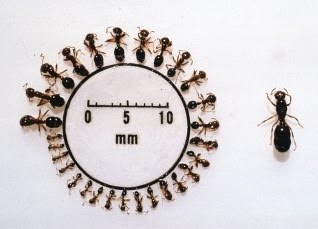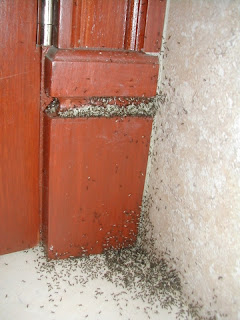Sometimes it seems that Honduras must have every type of ant in the world. Zompopos (leaf cutter ants - photo below) are the bane of gardeners and farmers who can see a rose bush or fruit tree completely defoliated in one night. Medium-sized black ants invade the house every now and then for no apparent reason and then disappear just as inexplicably.
 Very large light brown ants sneak into the house and lay big eggs a couple of times a year without you even knowing it — that is, until you pull some long unused item out of a cabinet or closet and have 50 giant ants and their sticky eggs fall onto your head! Aaack! Those ants are practically indestructible. Even stomping on them barely slows them down.
Very large light brown ants sneak into the house and lay big eggs a couple of times a year without you even knowing it — that is, until you pull some long unused item out of a cabinet or closet and have 50 giant ants and their sticky eggs fall onto your head! Aaack! Those ants are practically indestructible. Even stomping on them barely slows them down.Hormigas locas (crazy ants) are the tiny, tiny ants who swarm around in circles inside the house and manage to get into sealed bags, boxes and containers, inside the coffee pot, into the sink drains, everywhere. I don't know if they are called crazy ants because they run around in circles like they are crazy or because they can drive a person crazy by swarming up their arms and legs while the person is just standing in the kitchen or sitting at their desk or even while they are in bed. Here is a video of a Texas variety of crazy ants so you can see what I mean. The Caribbean crazy ant is smaller. I've tried to get videos but they are just too small to show up well.
I've adapted. I just pick out the ones that float in my coffee in the morning and drink it anyway. I generally have a live and let live policy when it comes to ants, unless they get really out of control, like the photo at top. After all, there are about a million ants for every person so it's not like we can ever hope to or should even try to eradicate them. Ants serve a purpose in the natural order of the universe.
But the worst of all ants, in my opinion, and the most aggressive and unbearable, are the fire ants. Fire ants are the small stinging ants which have invaded the US causing serious problems to gardeners, farmers, and livestock. Originally only a tropical pest, for decades now the ants have been spreading further north in the US each year. The stings really hurt and can cause blisters that itch for several hours. With a big enough infestation, fire ants can even kill livestock, especially small animals like baby chicks. Texas has a huge problem with fire ants so I had some experience with that.
The invasion!
For the past couple of months, fire ants have been invading the dog food dish on the terraza to the extent that the dogs wouldn't touch their food at all. The ants are really viciousness and their stings are painful. I would see the dogs frantically rolling around, trying to scratch their mouths and rubbing their face on the ground trying to remove the ants.
We had to use a large potted plant saucer filled with water as a moat with the dog food dish in the center — not really a good idea during a dengue epidemic! The ants would still get into the dog food. They got so bad that I couldn't even step onto the grass in the yard without them attacking my feet and legs. My garden was a miserable place to be for the dogs, the chickens, and us. I had to take back control!
A Texas treatment
In Texas, I used an organic agricultural product called dried molasses, which is actually some sort of residue from the sugar making process which is sprayed onto rice hulls or other grain residue and dried. It is inexpensive and is used for fertilizer, a livestock feed additive, and, you guessed it, fire ant control. The molasses obviously doesn't kill fire ants — they don't eat it — but what it does is to promote the growth of some sort of good microorganisms in the soil that attack fire ants. The ants instinctively know that and leave the area.
 Texas organic gardening guru the Dirt Doctor has a good article on fire ants. After fighting fire ants for many years in Texas and watching my neighbors use toxic chemicals — year after year after year — I know that getting them to go somewhere else is really the best you can hope for. Even Texas A & M university which strongly promotes chemical use confirms that. Texas fire ants have become resistant to the chemicals used and have adapted by hosting multiple queens in nests now instead of just one queen. Overuse of chemicals has resulted in the breeding of super ants. Like so many other issues, this is a man-made problem.
Texas organic gardening guru the Dirt Doctor has a good article on fire ants. After fighting fire ants for many years in Texas and watching my neighbors use toxic chemicals — year after year after year — I know that getting them to go somewhere else is really the best you can hope for. Even Texas A & M university which strongly promotes chemical use confirms that. Texas fire ants have become resistant to the chemicals used and have adapted by hosting multiple queens in nests now instead of just one queen. Overuse of chemicals has resulted in the breeding of super ants. Like so many other issues, this is a man-made problem.My unusual organic fire ant control
When I brought this up on our expatriate group (Honduras Living), I'm sure that some of my fellow expatriates thought it sounded nuts — and I really have to agree that it does sound crazy. But it worked!
If you are in the US, you can usually find dry molasses at feed stores or organic gardening supply stores. It wasn't available here in La Ceiba that I could find. Out of desperation, I tried regular sugar a few years ago and found it worked as well as the molasses. In the past 6 or 7 years, we've treated for fire ants three times, so it isn't something that you generally even have to repeat every year. But then, I don't have a lot of neighbors using chemicals either so that could make a difference. Another thing to consider is that most Honduran sugar is less refined, less white, and sometimes has a slight molasses flavor to it.
We sprinkled the sugar lightly on the soil, grass, and mulch all over the yard, including in the built-in jardineras (planter boxes), under the bushy plants, on the compost, on top of the soil in potted plants. You need to treat every single area outside except solid surfaces like concrete or tiled areas.
Amazingly, it worked instantly. I walked out in the garden just minutes later and not one single fire ant stung me. Even I wasn't expecting instant gratification. Now a week later, still not a fire ant in sight. Not in the dog food, not anywhere that we can see (or feel!). The ants have gone on to terrorize other areas.
Arexy and Jorge, our current occasional yard helper, were very skeptical. I recommended to another gringa that if her neighbors asked, to tell them that she was using a highly toxic chemical, not sugar, in order to gain approval. Otherwise they would think she was crazy!
This time we used an old small hand-held grass seed/fertilizer spreader that holds about 1-1 1/2 pounds of sugar. It worked very well on the finest setting, but you can just throw it around by hand, too. In total we used about 5 kilos of sugar (about 11 pounds) but we have a pretty big yard. I wish I could be more exact, but it doesn't take much. When spreading it around, you shouldn't see it covering any area — think of it as similar to very lightly salting your food. The key is to get some sugar everywhere. We had a heavy rain that night, so rain or watering will not wash away the effectiveness.
I can't guarantee that this will work for you, but if you have a similar problem with fire ants, it is definitely worth a try. You don't have to worry about your kids or animals being exposed to (or eating!) chemicals. It's cheap compared to chemical methods and easy to give it a try. I hope that you will let me know if it worked for you.
Good luck with those ants!
See also, How to get ants out of the sugar



 Welcome to my Blogicito —
Welcome to my Blogicito — 







